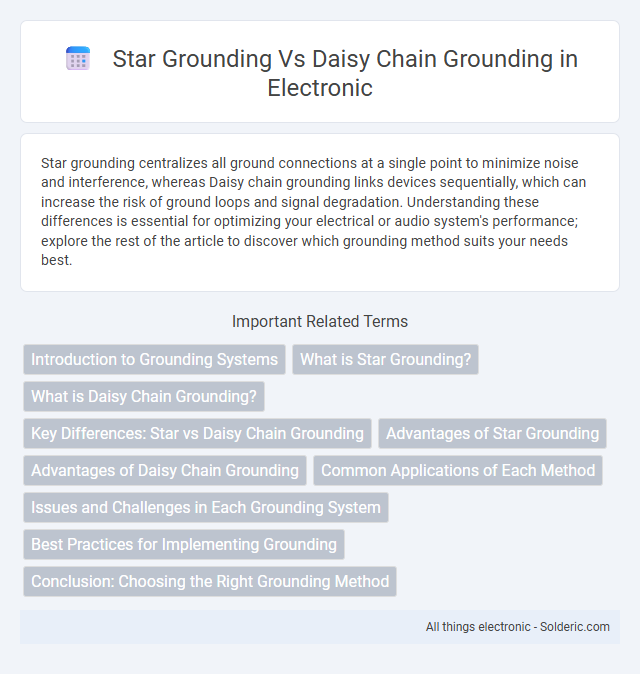Star grounding centralizes all ground connections at a single point to minimize noise and interference, whereas Daisy chain grounding links devices sequentially, which can increase the risk of ground loops and signal degradation. Understanding these differences is essential for optimizing your electrical or audio system's performance; explore the rest of the article to discover which grounding method suits your needs best.
Comparison Table
| Feature | Star Grounding | Daisy Chain Grounding |
|---|---|---|
| Grounding Structure | Single central grounding point connected to all devices | Devices grounded sequentially, connected in series |
| Noise Interference | Minimal interference due to isolated paths | Higher risk of noise propagation between devices |
| Fault Isolation | Easy to detect and isolate faults | Faults can affect downstream devices |
| Installation Complexity | More complex wiring, requires central point | Simpler wiring, devices connected one after another |
| Cost | Potentially higher due to more cabling | Lower cabling costs |
| Use Case | Preferred in sensitive or noise-critical systems | Suitable for simple or low-noise applications |
Introduction to Grounding Systems
Star grounding systems centralize all ground connections at a single point, minimizing ground loops and reducing electrical noise in sensitive electronic circuits. Daisy chain grounding connects multiple components sequentially, which can introduce voltage drops and interference due to shared grounding paths. Effective grounding design enhances circuit stability and signal integrity by controlling noise and preventing unwanted current flow.
What is Star Grounding?
Star grounding is a grounding technique where all ground connections converge at a single central point, minimizing interference by preventing ground loops. This method reduces noise and potential differences between system components, improving overall electrical performance in sensitive circuits. Star grounding is especially effective in complex electronic systems requiring stable and clean reference grounds.
What is Daisy Chain Grounding?
Daisy chain grounding refers to a method where multiple electrical components are connected sequentially to a single ground wire, creating a chain-like path for grounding current. This configuration can lead to higher resistance and potential ground loop issues, affecting signal integrity and increasing noise in sensitive electronic circuits. Unlike star grounding, which connects all grounds independently to a common point, daisy chain grounding is simpler but less effective for minimizing interference in complex systems.
Key Differences: Star vs Daisy Chain Grounding
Star grounding uses a single central grounding point where all equipment grounds converge, minimizing ground loops and electrical noise. Daisy chain grounding connects devices sequentially, creating a continuous path that can introduce interference and voltage drops. Star grounding ensures better signal integrity and safety, especially in sensitive electronic systems.
Advantages of Star Grounding
Star grounding offers superior noise reduction by providing a single reference point for all ground connections, minimizing ground loops and interference. This method enhances signal integrity and stability in complex electrical systems by preventing voltage differences between equipment grounds. Star grounding is especially advantageous in sensitive audio, communication, and measurement applications where clean, consistent grounding is critical.
Advantages of Daisy Chain Grounding
Daisy chain grounding offers simpler installation and reduced material costs by linking multiple devices in series with a single grounding conductor. This method minimizes ground loop areas, helping to reduce electromagnetic interference in specific setups. Your system benefits from easier troubleshooting and scalability when adding or modifying components in the grounding path.
Common Applications of Each Method
Star grounding is commonly used in audio and telecommunications systems to prevent ground loops and minimize electrical noise by providing a single, central grounding point. Daisy chain grounding finds frequent application in industrial control panels and machinery where multiple devices are grounded sequentially for simplified wiring and cost efficiency. Choosing between these methods depends on Your system's susceptibility to noise interference and the complexity of the grounding layout.
Issues and Challenges in Each Grounding System
Star grounding minimizes the risk of ground loops by connecting all equipment to a single common point, but improper layout can lead to voltage drops and interference issues. Daisy chain grounding creates a simple, linear connection that may be easier to implement yet risks increased ground resistance and potential signal degradation from ground loops. Your choice requires balancing electrical noise reduction with installation complexity to ensure system stability and signal integrity.
Best Practices for Implementing Grounding
Star grounding minimizes ground loops by connecting all ground points to a single central node, enhancing signal integrity and reducing electromagnetic interference in your electrical system. Daisy chain grounding links equipment grounds sequentially, which can introduce noise and potential differences, making it less ideal for sensitive applications. For best practices, always use star grounding in complex installations to ensure reliable reference potential and maintain system stability.
Conclusion: Choosing the Right Grounding Method
Star grounding offers superior noise reduction by connecting each device directly to a single grounding point, minimizing ground loops and ensuring signal integrity. Daisy chain grounding may be simpler to implement but increases the risk of interference and voltage drops due to shared grounding paths. Your choice depends on system complexity and sensitivity, with star grounding preferred for high-precision electronics requiring stable, low-noise operation.
Star grounding vs Daisy chain grounding Infographic

 solderic.com
solderic.com